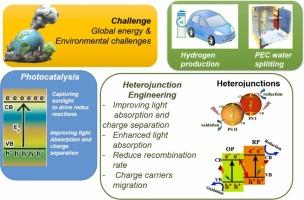光催化中的工程电荷转移途径:Z-, S-, R-和c -机制的综合综述
IF 6.3
2区 材料科学
Q2 CHEMISTRY, PHYSICAL
引用次数: 0
摘要
光催化是一种很有前途的可持续能源转换策略,但其大规模部署受到电荷产生、分离和利用方面的持续挑战的限制。界面设计的最新进展导致了四种不同的电荷转移架构,即Z-, S-, R-和c -方案,重塑了电子和空穴如何迁移,相互作用和驱动氧化还原反应。每种方案都具有独特的优势:z方案通过选择性重组保持强大的氧化还原能力,s方案利用内部电场进行定向载流子流动,r方案利用供体-受体框架进行受控电荷迁移,c方案积累电荷以实现多电子过程。因此,本文对这些体系结构进行了批判性的评估,强调了它们的机械原理以及在效率、成本和耐用性方面的权衡。特别关注基于金属-金属氧化物/金属-金属氧化物及其与碳质材料集成的异质结,这些异质结可以增强界面电荷动力学,扩大光吸收,提高结构稳健性。虽然Z-和s -方案相对成熟并经过实验验证,但R-和c -方案仍处于早期阶段,但在选择性和复杂催化过程中显示出强大的潜力。未来的发展方向是设计高效、稳定、可扩展的光催化系统,与可持续能源目标保持一致。本文章由计算机程序翻译,如有差异,请以英文原文为准。

Engineering Charge Transfer Pathways in Photocatalysis: A Comprehensive Review of Z-, S-, R-, and C-scheme Mechanisms
Photocatalysis is a promising strategy for sustainable energy conversion, yet its large-scale deployment is constrained by persistent challenges in charge generation, separation, and utilization. Recent advances in interfacial design have led to four distinct charge-transfer architectures, namely Z-, S-, R-, and C-schemes that reshape how electrons and holes migrate, interact, and drive redox reactions. Each scheme provides unique benefits: Z-schemes retain strong redox ability through selective recombination, S-schemes exploit internal electric fields for directional carrier flow, R-schemes utilize donor–acceptor frameworks for controlled charge migration, and C-schemes accumulate charges to enable multi-electron processes. Therefore, this review critically evaluates these architectures, highlighting both their mechanistic principles and trade-offs in efficiency, cost, and durability. Special attention is given to heterojunctions based on metal–metal oxides/metal-metal oxide and their integration with carbonaceous materials, which enhance interfacial charge dynamics, broaden light absorption, and improve structural robustness. While Z- and S-schemes are relatively mature and experimentally validated, R- and C-schemes remain at an early stage but show strong potential for selective and complex catalytic processes. Future directions are outlined for designing efficient, stable, and scalable photocatalytic systems aligned with sustainable energy goals.
求助全文
通过发布文献求助,成功后即可免费获取论文全文。
去求助
来源期刊

Journal of Alloys and Compounds
工程技术-材料科学:综合
CiteScore
11.10
自引率
14.50%
发文量
5146
审稿时长
67 days
期刊介绍:
The Journal of Alloys and Compounds is intended to serve as an international medium for the publication of work on solid materials comprising compounds as well as alloys. Its great strength lies in the diversity of discipline which it encompasses, drawing together results from materials science, solid-state chemistry and physics.
 求助内容:
求助内容: 应助结果提醒方式:
应助结果提醒方式:


